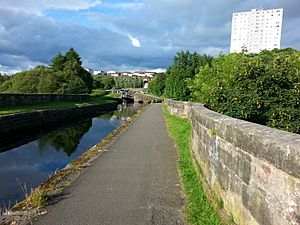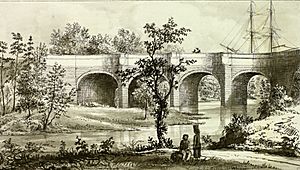Kelvin Aqueduct facts for kids
Quick facts for kids Kelvin Aqueduct |
|
|---|---|

The Forth and Clyde Canal passing over the Kelvin Aqueduct
|
|
| Carries | Forth and Clyde Canal |
| Crosses | River Kelvin |
| Characteristics | |
| Material | Stone |
| Longest span | 50 ft (15 m) |
| Number of spans | 4 |
| History | |
| Construction end | 1787 |
| Construction cost | £8,509 |
| Opened | 1790 |
The Kelvin Aqueduct is a special kind of bridge in Glasgow, Scotland. It's called a navigable aqueduct because it carries boats! This amazing structure allows the Forth and Clyde Canal to cross high above the River Kelvin. Imagine boats sailing over your head!
History of the Aqueduct
The Kelvin Aqueduct was designed by Robert Whitworth. He was a supervising engineer for the big Forth and Clyde Canal project. The main engineer for the canal was John Smeaton, a very famous builder.
The actual building work was done by William Gibb and John Muir. William Gibb later started a family of engineers who built many important things. They also built the nearby Maryhill locks, which are like water elevators for boats.
Building the aqueduct started on June 16, 1787. A special "foundation stone" was laid by Archibald Spiers. He was the head of the canal committee at the time.
When the aqueduct opened in 1790, it was the largest of its kind in Britain. People were amazed to see sailing boats moving high above them. The whole project cost about £8,509. This was more than the original plan of £6,200.
In 1989, the Kelvin Aqueduct was given a special protection. It became a category A listed building. This means it's a very important historical structure that needs to be preserved.
How the Aqueduct Was Built
The Kelvin Aqueduct is about 445 feet (136 meters) long. It has four large arches, each about 50 feet (15 meters) wide. The top of the aqueduct stands about 62 feet (19 meters) above the river.
Engineers made sure the canal bed on the aqueduct was strong. There was about 3 feet (1 meter) of special "puddle clay" at the bottom. This clay helps to stop water from leaking out. The aqueduct was designed to hold about 8 feet (2.4 meters) of water for the boats.
The piers, which are the supports for the arches, look like the pointed ends of a boat. These are called "cutwaters." However, only one pier actually sits in the river. The sides of the aqueduct are also arched. This design helps to push the water's weight outwards onto the strong supports. You can clearly see this clever design from above. A similar design was used on the Luggie Aqueduct near Kirkintilloch, which opened earlier in 1773.
The lower parts of the aqueduct are built with rough, natural-looking stone called "rustic masonry." The upper parts use smoother, finely cut stone called "polished ashlar." Below the aqueduct, you can find the Kelvin Walkway. This path runs through a green area along the river, perfect for a stroll.


